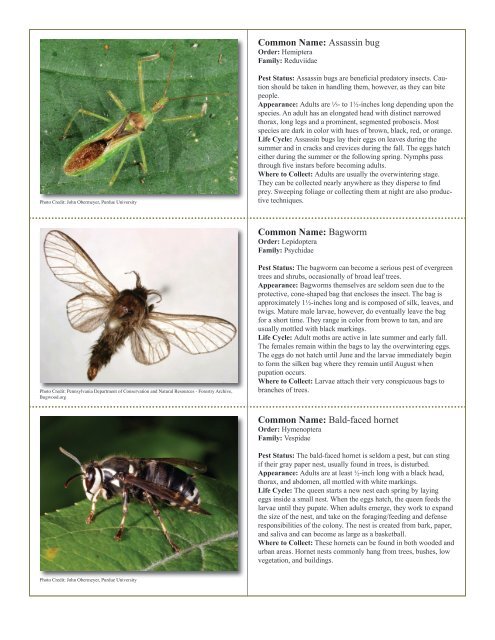to download pdf - Purdue Extension Entomology - Purdue University
to download pdf - Purdue Extension Entomology - Purdue University
to download pdf - Purdue Extension Entomology - Purdue University
Create successful ePaper yourself
Turn your PDF publications into a flip-book with our unique Google optimized e-Paper software.
Common Name: Assassin bug<br />
Order: Hemiptera<br />
Family: Reduviidae<br />
Pho<strong>to</strong> Credit: John Obermeyer, <strong>Purdue</strong> <strong>University</strong><br />
Pest Status: Assassin bugs are beneficial preda<strong>to</strong>ry insects. Caution<br />
should be taken in handling them, however, as they can bite<br />
people.<br />
Appearance: Adults are 1 ⁄5- <strong>to</strong> 1½-inches long depending upon the<br />
species. An adult has an elongated head with distinct narrowed<br />
thorax, long legs and a prominent, segmented proboscis. Most<br />
species are dark in color with hues of brown, black, red, or orange.<br />
Life Cycle: Assassin bugs lay their eggs on leaves during the<br />
summer and in cracks and crevices during the fall. The eggs hatch<br />
either during the summer or the following spring. Nymphs pass<br />
through five instars before becoming adults.<br />
Where <strong>to</strong> Collect: Adults are usually the overwintering stage.<br />
They can be collected nearly anywhere as they disperse <strong>to</strong> find<br />
prey. Sweeping foliage or collecting them at night are also productive<br />
techniques.<br />
Common Name: Bagworm<br />
Order: Lepidoptera<br />
Family: Psychidae<br />
Pho<strong>to</strong> Credit: Pennsylvania Department of Conservation and Natural Resources - Forestry Archive,<br />
Bugwood.org<br />
Pest Status: The bagworm can become a serious pest of evergreen<br />
trees and shrubs, occasionally of broad leaf trees.<br />
Appearance: Bagworms themselves are seldom seen due <strong>to</strong> the<br />
protective, cone-shaped bag that encloses the insect. The bag is<br />
approximately 1½-inches long and is composed of silk, leaves, and<br />
twigs. Mature male larvae, however, do eventually leave the bag<br />
for a short time. They range in color from brown <strong>to</strong> tan, and are<br />
usually mottled with black markings.<br />
Life Cycle: Adult moths are active in late summer and early fall.<br />
The females remain within the bags <strong>to</strong> lay the overwintering eggs.<br />
The eggs do not hatch until June and the larvae immediately begin<br />
<strong>to</strong> form the silken bag where they remain until August when<br />
pupation occurs.<br />
Where <strong>to</strong> Collect: Larvae attach their very conspicuous bags <strong>to</strong><br />
branches of trees.<br />
Common Name: Bald-faced hornet<br />
Order: Hymenoptera<br />
Family: Vespidae<br />
Pest Status: The bald-faced hornet is seldom a pest, but can sting<br />
if their gray paper nest, usually found in trees, is disturbed.<br />
Appearance: Adults are at least ½-inch long with a black head,<br />
thorax, and abdomen, all mottled with white markings.<br />
Life Cycle: The queen starts a new nest each spring by laying<br />
eggs inside a small nest. When the eggs hatch, the queen feeds the<br />
larvae until they pupate. When adults emerge, they work <strong>to</strong> expand<br />
the size of the nest, and take on the foraging/feeding and defense<br />
responsibilities of the colony. The nest is created from bark, paper,<br />
and saliva and can become as large as a basketball.<br />
Where <strong>to</strong> Collect: These hornets can be found in both wooded and<br />
urban areas. Hornet nests commonly hang from trees, bushes, low<br />
vegetation, and buildings.<br />
Pho<strong>to</strong> Credit: John Obermeyer, <strong>Purdue</strong> <strong>University</strong>
















